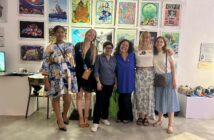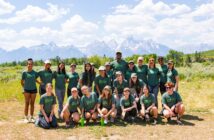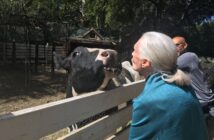How do you save a species? Dr. Anne Savage has some ideas! Recently, conservationist, freelance writer, and friend of the Jane Goodall Institute (JGI), Bill Boteler, wrote an article for Conservation Careers on the inspiring work of Dr. Savage, who has been studying and trying to protect Colombia’s Cotton-top Tamarin for 40 years. He spoke to her about her story with this species, her successes and challenges, and ultimately, the necessity of community-led conservation in protecting the tamarin.
Dr. Savage started her journey with Cotton-top Tamarins in undergrad at the University of Wisconsin. She first learned about them from afar, but then was given the opportunity to start the first long-term field study of the species in their native habitat in the country of Colombia. It was there that she had a realization:
While there were many efforts to conserve this species in managed care, I realized that if I wanted to help save cotton-top tamarins, it needed to happen in-country. When I went to Colombia for the first time very few people understood that cotton-tops were an endangered species.
It became clear to me that it didn’t matterhow many Americans in the U.S. were interested in saving this animal, we needed to get Colombians involved in wanting to save cotton-top tamarins. That’s really how it all started for me.
Dr. Anne Savage
She knew that they had to start with the communities around this endangered species’ home, so Dr. Savage and other conservationists worked with local Colombians to spread awareness about this tamarin, and how it was negatively impacted by activities like deforestation, which also harmed human communities. While doing so, they worked together to come up with alternative, sustainable livelihoods for those who relied on the tamarin and their habitat:
We’re in the process of connecting a lot of these isolated forest patches within the historic distribution of cotton-tops. We have a program in the area of San Juan Nepomuceno that is connecting small forest patches to create forest corridors to a national park where cotton-tops are found. We also work with local farmers and create an agreement where they set aside a portion of their land in a conservation easement and we work with them to better their agricultural production efforts by enhancing their farming techniques. It’s been a win-win for everybody.
They’ve even found a lucrative alternative to the illegal and cruel tamarin pet trade:
We also have artisans that are making plush cotton-top tamarin toys. When we first started working in Colombia, there were no plush toys. If a child wanted to have some type of representation of a cotton-top, they would get a wild one as a pet. We wanted to be able to substitute wild cotton-tops for plush cotton-tops.
Dr. Anne Savage and other allies of the Cotton-top Tamarin are looking to Colombia’s youth as the future of Cotton-top Tamarin conservation, by helping them to understand the importance of this species, and providing pathways to help out.
We also work with youth to inspire them to care about cotton-tops. We have a series of educational programs starting in elementary school through high school. We even have opportunities for students to come back and work with us on various short-term projects.
It’s fun to have some of our kids that have gone through our early education programs come back and help out on various activities or take the information they learned from us to become educators at the zoo in Bogota, or work in local and governmental agencies. It’s exciting to see how we have also inspired others, like local and international artists who are now sharing the need to conserve cotton-tops with new audiences.
While Dr. Savage went to Colombia to study the Cotton-top Tamarins and to work on her Ph.D. thesis, being in the native country of this species she loved taught her that conservation requires a flexible and multi-disciplinary approach—no one action alone is going to be the solution, and sometimes, you have to be open to unique and unexpected possibilities!
As someone who is an expert in cotton-top tamarin behaviour, I never thought I would pivot to working on creative solutions in sustainable development such as teaching women to crochet beautiful tote bags called eco-mochilas out of recycled plastic bags!
Learn More
Learn how the Jane Goodall Institute has been a leading voice on community-led conservation through our 🔗 Tacare approach to protect chimpanzees and other endangered species for nearly 30 years. Also learn more about JGI’s youth empowerment program, which inspires the next generation of conservation leaders – 🔗 Roots & Shoots.
Read the rest of Bill Boteler’s article for Conservation Careers on Dr. Savage’s work conserving the Cotton-topped Tamarin here: 🔗 “Saving a One-pound Monkey Takes Creativity.”






